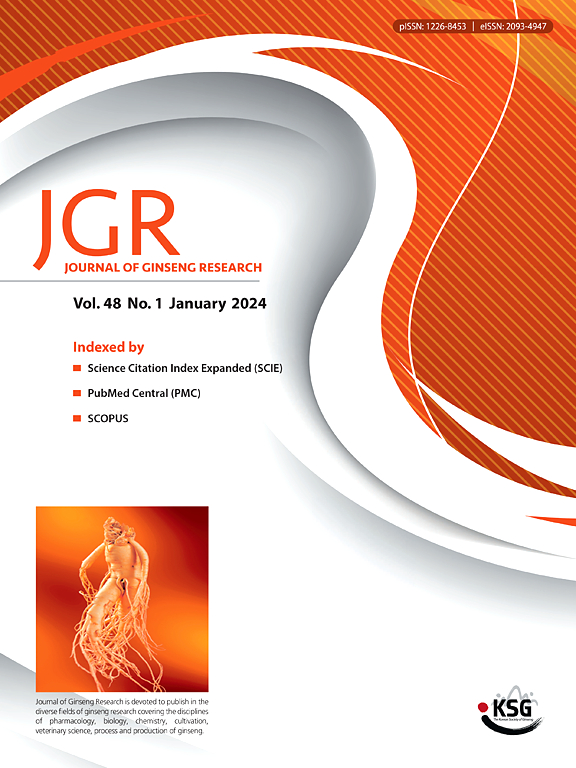The antitumor effects and apoptotic mechanism of 20(S)-Protopanaxadiol in acute myeloid leukemia
IF 6.8
2区 医学
Q1 CHEMISTRY, MEDICINAL
引用次数: 0
Abstract
Background
Panax ginseng Meyer is a well-known herb in traditional Chinese medicine, with ginsenosides being its primary bioactive components. Among these, 20(S)-protopanaxadiol (20(S)-PPD) has demonstrated anti-tumor effects in various cancers. However, its role in acute myeloid leukemia (AML) remains unclear.
Methods
MTT assays were conducted to assess the impact of 20(S)-PPD on AML cell proliferation, while flow cytometry was used to analyze its effects on apoptosis. Western blotting and network pharmacology analyses were employed to explore the signaling pathways and protein expression levels modulated by 20(S)-PPD in AML. c-Myc mRNA levels in AML cells were quantified using RT-PCR.
Results
20(S)-PPD effectively inhibits proliferation and induces apoptosis in AML cells, both in vitro and in patient samples. It achieves this by inhibiting the PI3K/AKT/mTOR pathway and activating the PERK/ATF4/CHOP pathway. Additionally, 20(S)-PPD reduces c-Myc protein and mRNA levels, primarily by decreasing c-Myc mRNA stability. Moreover, combining 20(S)-PPD with ABT-199 significantly enhances pro-apoptotic effects and markedly reduces c-Myc protein and mRNA levels in both AML and cytarabine-resistant (AraC-R) AML cells. This combination therapy holds promise for overcoming resistance and improving treatment outcomes in AML.
Conclusion
This study demonstrates the potent antitumor activity of 20(S)-PPD in AML and elucidates its underlying mechanisms. Notably, 20(S)-PPD exhibits significant antitumor effects against AML cells, both as a single agent and in combination with ABT-199, where it displays pronounced synergy. These results suggest a promising new therapeutic strategy for AML treatment.

20(S)-原嘌呤二醇对急性髓细胞白血病的抗肿瘤作用及凋亡机制
人参是一种著名的传统中药,人参皂苷是其主要的生物活性成分。其中,20(S)-protopanaxadiol (20(S)-PPD)在多种癌症中显示出抗肿瘤作用。然而,其在急性髓性白血病(AML)中的作用尚不清楚。方法采用smtt法观察20(S)-PPD对AML细胞增殖的影响,流式细胞术观察其对细胞凋亡的影响。采用Western blotting和网络药理学分析,探讨20(S)-PPD在AML中调控的信号通路和蛋白表达水平。结果20(S)-PPD在体外和患者样本中均能有效抑制AML细胞增殖并诱导细胞凋亡。它通过抑制PI3K/AKT/mTOR通路和激活PERK/ATF4/CHOP通路来实现这一目标。此外,20(S)-PPD降低c-Myc蛋白和mRNA水平,主要是通过降低c-Myc mRNA的稳定性。此外,20(S)-PPD联合ABT-199可显著增强AML和阿糖胞苷耐药(AraC-R) AML细胞的促凋亡作用,并显著降低c-Myc蛋白和mRNA水平。这种联合治疗有望克服耐药性并改善AML的治疗结果。结论本研究证实20(S)-PPD在AML中具有较强的抗肿瘤活性,并阐明其作用机制。值得注意的是,无论是单独使用还是与ABT-199联合使用,20(S)-PPD对AML细胞都表现出显著的抗肿瘤作用,并表现出明显的协同作用。这些结果为AML治疗提供了一个有希望的新治疗策略。
本文章由计算机程序翻译,如有差异,请以英文原文为准。
求助全文
约1分钟内获得全文
求助全文
来源期刊

Journal of Ginseng Research
CHEMISTRY, MEDICINAL-INTEGRATIVE & COMPLEMENTARY MEDICINE
CiteScore
11.40
自引率
9.50%
发文量
111
审稿时长
6-12 weeks
期刊介绍:
Journal of Ginseng Research (JGR) is an official, open access journal of the Korean Society of Ginseng and is the only international journal publishing scholarly reports on ginseng research in the world. The journal is a bimonthly peer-reviewed publication featuring high-quality studies related to basic, pre-clinical, and clinical researches on ginseng to reflect recent progresses in ginseng research.
JGR publishes papers, either experimental or theoretical, that advance our understanding of ginseng science, including plant sciences, biology, chemistry, pharmacology, toxicology, pharmacokinetics, veterinary medicine, biochemistry, manufacture, and clinical study of ginseng since 1976. It also includes the new paradigm of integrative research, covering alternative medicinal approaches. Article types considered for publication include review articles, original research articles, and brief reports.
JGR helps researchers to understand mechanisms for traditional efficacy of ginseng and to put their clinical evidence together. It provides balanced information on basic science and clinical applications to researchers, manufacturers, practitioners, teachers, scholars, and medical doctors.
 求助内容:
求助内容: 应助结果提醒方式:
应助结果提醒方式:


